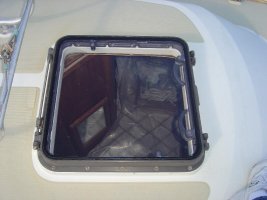Hi folks,
I am finishing up my first overhead hatch this weekend - replacement of the 1/2-inch thick acrylic. Learned alot, didn't swear too much, turned out pretty good (iidssm*). This weekend I'll take it to the boat for a test fit and see if I have to replace the gasket also.
I used Sikaflex 295-UV and their 226 cleaner and 209 primer. Their excellent directions recommend, for non-smoked acrylic (mine is clear), that a 1 inch border be added to the outer surface to block UV from getting to the bond surface.
Good idea I'm sure. I do not want to add a plastic or metal frame, so I've decided to paint the border. I was wondering if you had any experience painting acrylic sheet. I was thinking spray paint, something like a Krylon.
I think I'll take some pictures on the next hatch and perhaps post a project in the appropriate section. It wasn't hard, just labor intensive, and the cost is much less than the $500 each I was likely to pay if I hired an expert.
(* if I do say so myself)
I am finishing up my first overhead hatch this weekend - replacement of the 1/2-inch thick acrylic. Learned alot, didn't swear too much, turned out pretty good (iidssm*). This weekend I'll take it to the boat for a test fit and see if I have to replace the gasket also.
I used Sikaflex 295-UV and their 226 cleaner and 209 primer. Their excellent directions recommend, for non-smoked acrylic (mine is clear), that a 1 inch border be added to the outer surface to block UV from getting to the bond surface.
Good idea I'm sure. I do not want to add a plastic or metal frame, so I've decided to paint the border. I was wondering if you had any experience painting acrylic sheet. I was thinking spray paint, something like a Krylon.
I think I'll take some pictures on the next hatch and perhaps post a project in the appropriate section. It wasn't hard, just labor intensive, and the cost is much less than the $500 each I was likely to pay if I hired an expert.
(* if I do say so myself)

